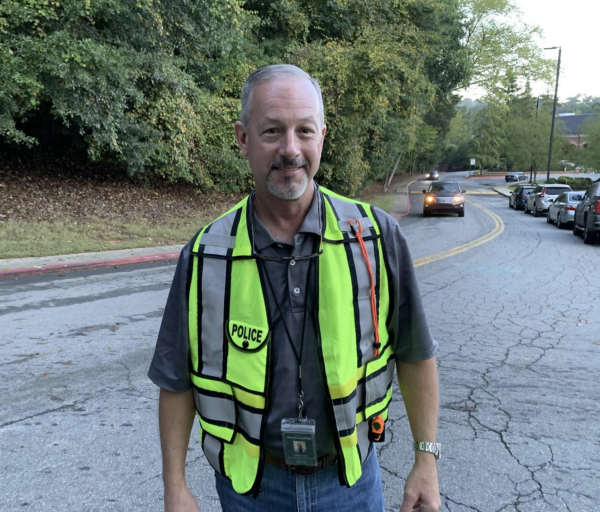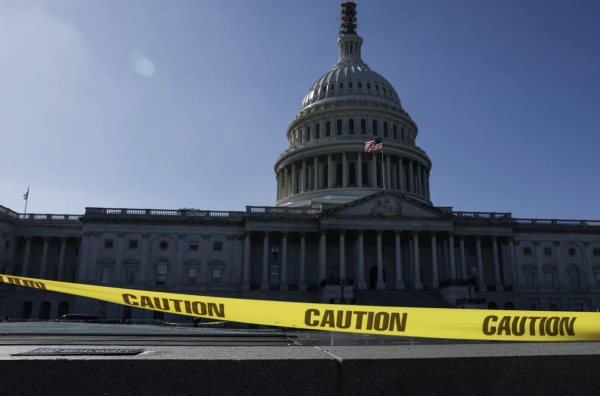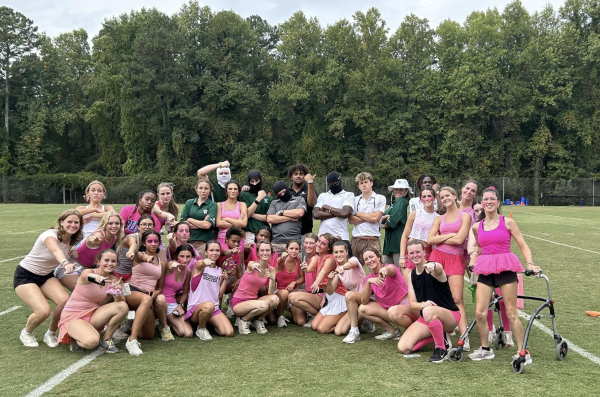Reported concussions on the rise, impede sports, school
Photo credit CMC
The past year, nearly four million concussions were reported nationally, double what was reported in 2002. In fact, concussions account for nearly 15 percent of all sports-related injuries reported to athletic trainers. The recent influx of concussions is primarily due to sports, which is the second highest cause of traumatic brain injuries behind motor vehicle crashes.
“We have seen everything, from slipping in the bathroom and hitting their head on the floor, taking an elbow in basketball practice, [and] falling off a horse,” said Lauren Carter, an athletic trainer at Westminster. “Anything that jars the brain or causes a sloshing of the brain can cause a concussion.”
“I got my concussion during football practice in a full contact scrimmage,” said freshman Jack Crawford.
Sophomore Mary Tucker also received a concussion from playing a school sport.
“I was hit in the head at volleyball practice, in the nose,” said Tucker. “It was not a very hard ball, but my nose did start bleeding.”
Concussions can even occur without physical contact.
“Their head doesn’t have to hit anything,” said Carter, “but the quick motion of the head to be thrown forwards and backwards causes the brain to slosh in the skull which can cause concussion.”
After concussions, students experience symptoms such as headaches, vomiting, sensitivity to noise and light, and numbness.
“You feel sick all the time,” said freshman Will Finley. “You always have massive headaches.”
Senior Walker Jones also had a nauseating experience with concussions.
“I threw up a ton and had bad headaches, said Jones, “and I felt out of it.”
Students are advised to follow specific guidelines to cope with concussions.
“You are not supposed to be stimulated,” said Finley. “You are banned from lights, TV, reading, and you are supposed to sleep a lot.”
The athletic trainers use a procedure to enforce those guidelines for students.
“We call their parents and let them know and we give them a care sheet which has things to watch for, what you can and can’t do,” said Donna Hays, an athletic trainer at Westminster, “such as TV, video games, computer, reading and homework.”
Students regularly see doctors and trainers inside and outside of school to help with the concussion healing process.
“Students come to us, and if they have a concussion, we send them to a specialist,” said Carter, “either a neurologist or a physician who specializes in sport concussions.”
Although school trainers provide initial concussion help, outside doctors provide crucial assistance for recovery.
“I went to the trainer at first, and they got the process going,” said Tucker. “After I came home one day from school with a massive headache, my mom took me to the doctor, the Sports Concussion Institute.”
Concussions not only affect an athlete’s athletic ability but also their return to school and normal life.
“It was hard to catch up with schoolwork,” said Jones. “I just had to focus more and do more work, but my teachers were very helpful.”
Tucker also experienced a difficult time making up schoolwork.
“It took me a while to catch up, because while I was catching up on one subject I was getting further behind in others,” said Tucker. “I was unable to do the current work because I was so busy with old work.”
Despite the difficulty catching up with academics, teachers have helped injured students along the path of recovery.
“The teachers are very into the return and until this year, they had no guidelines and they came up with their own ways to help students,” said Hays. “Dr. Moore has come up with new guidelines in academics. Every step as you progress in your healing process, we will help you in your mental return.”
Teachers have used various methods to assist students who process concepts slower as a result of a concussion.
“A few teachers didn’t make me do some of the old homework, but I had to do all major assignments,” said Tucker. “I got extended time on tests and quizzes because my thinking process was slowed down for about a month.”
Finley was also excused from schoolwork for a period of time.
“[My teachers] didn’t make me do schoolwork,” said Finley, “since I was out for so long.”
Westminster uses a specific protocol to further aid students in their return to academics and sports. First, students feeling concussion symptoms will fill out a sheet with a series of questions, where they rate the level of pain in a variety of symptoms from zero to six. The trainers add together the numbers to estimate the severity of the injury.
“Our protocol at Westminster is once we think someone has a concussion, we shut them down for at least 48 hours,” said Hays, “and one of the things that research says is that if you shut the brain down for 48 hours, it helps the process.”
Next, athletic trainers use tests such as the impact test to calculate concussion severity. The impact test measures concussion symptoms by having an athletic trainer conduct a variety of assessments. When Tucker first suffered her injury, she did not believe she had a concussion. However, the impact test exposed many common concussion symptoms that Tucker had not experienced before.
“[During the test], I could not remember anything for more than a few seconds, and my hand-eye coordination was way off,” said Tucker. “One of the tests at the doctor included following a piece of paper with my eyes. After just one try, my head was pounding. I also had horrible balance. I could not walk in a straight line or stand on one foot.”
After performing the impact test, trainers reassess a student’s condition.
“If they are okay,” said Hays, “then we have them come in for a half day to just sit in school.”
However, some students are sidelined from school for a period of time before being mentally capable of returning to academics.
“Definitely if there’s a concussion, they do process slower,” said Carter. “That’s why we have to take them out of their classroom setting and modify their schoolwork because they are slower at it and the more they try to cognitively use their brain, the longer it takes them to heal.”
The return to school may take several days to several weeks depending on the severity of the concussion.
“I didn’t go to school for about half a week,” said Crawford.
When students are able to return to school, they sit in class but do not do any schoolwork in order to rest their mental body.
After students become accustomed to sitting for a half day, they progress to a full day. However, most students have trouble listening in class in the weeks following a concussion.
“What most kids will complain to us about is that they will be sitting in class trying to focus on what the teacher is telling them,” said Carter. “It’s almost like it goes in one ear and goes out another ear, and they can’t comprehend what they are being told, so their short term memory is not very good.”
Once students are symptom free and able to work, the trainers test students physically.
“We use our return-to-play protocol by stressing them physically, starting with putting them on the treadmill because sometimes physical stress will cause symptoms to recur so we want to put them through the process,” said Hays. “If symptoms happen, we start the whole process over again.”
For some students, the process only lasts several days or weeks before the concussion heals.
“After two or three weeks,” said Crawford, “I recovered and could play football again.”
However, for other students, recovery can take several painful months.
“Sometimes when they get past that four to five week marker, they go into post concussive syndrome,” said Carter. “This can go for months, and it means that they are still having some signs of depression because of the concussion or having issues with say, watching a basketball game, [and] the motion of the people causes them to have headaches again.”
However, the post-concussive syndrome eventually wears away after several months.
“It took me five very tough months to recover,” said Finley. “It varies with different people.”
It is also difficult for friends of injured students to watch their peers struggle with everyday life.
“I know people who had concussions,” said freshman Josh Stich. “It takes a while to get back into being able to do everything at full speed, and it’s hard for me to watch my friends go through that process.”
Despite the tough road, students usually recover from concussions and return to their respective sports.
“I returned to the football field in two to three weeks,” said Crawford, “and the feeling of being able to play again was amazing.”
Finley also returned to physical exercise after his concussion recovery.
“After a couple months, I could move freely without worrying about massive headaches,” said Finley. “That feeling was amazing.”
However, some people are not as lucky.
“I can’t play any more sports which stinks,” said Jones, “but I’m over [not playing] to be safe.”
Tucker also experienced frustrations in being sidelined from her sport.
“I have not gone a week without a headache since [my concussion],” said Tucker, “and cannot play volleyball.”
Although the number of concussions reported increases every year, the athletic discipline is improving concussion recovery processes and safety.
“I think there has been an increase in concussions because we are more aware of what a concussion is now and there is so much more research out there that people are now talking about concussions rather than saying I just got knocked out or got dinged up,” said Carter. “They used to grade concussions as mild, moderate, or severe, but now, if you say you got a ding, and if you have more than thirty or forty minutes of disruption in how you normally feel, then you get a concussion.”
Jones agreed with Carter.
“There’s an increase in concussions because people are now aware of concussions,” said Jones.
Despite progression in the medical world of concussions, concussions can still be very dangerous to students.
“They are dangerous because a lot of times people won’t realize that they have a concussion at first, like I did,” said Tucker. “That’s when it really started to bite.”
Moreover, concussions can be more dangerous to developing minors than to adults.
“It’s dangerous for adolescents more than adults because adolescents’ brains are still developing, and when you have a concussion it causes chemical imbalance and that causes neurons to go crazy and can lead to slow speech and eventually death,” said Carter. “But you see that a lot more in adolescents because their brain is still developing. And they also have second impact syndrome, where you haven’t recovered from one concussion and you get another hit, and that can lead to death.”
Even though concussion methods have improved, concussions are risky and can cause deep consequences. Without proper care, a second blow to the head while recovering from an initial concussion can lead to death. Moreover, concussions can lead to never-ending symptoms if not treated correctly.
“I still played a whole game after getting hit,” said Tucker. “It was until afterwards that I started to have a headache. If I hadn’t been with my friends then, I probably would have ignored it. In addition to this, the more concussions you get, the worse your condition gets. I know someone who got multiple concussions in high school and still has side effects after college. “








